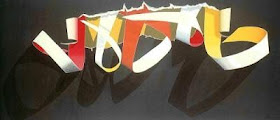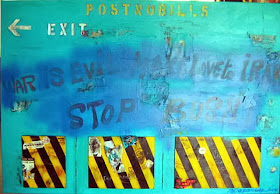A
PAINTER BURHAN DOĞANÇAY - ISTANBUL
Half a Century of Urban Culture:
A
A
A
PAINTER BURHAN DOĞANÇAY - ISTANBUL
Half a Century of Urban Culture:
Burhan Doğançay is one of the few artists who have kept a record of the times we live in through the use of walls, which are among the key symbols of modern and contemporary urban culture. His practice of thought and production are both shaped by examining walls that reflect the contemporary memory of socio – cultural transformation, and by becoming a stakeholder in the history of walls, which constitute a public field of expression. This energetic transformation, which from the early 1960 s to the present day has constructed new fields of social, cultural, and political discourse through the medium of walls, holds a light to the complex and protean alternative history of urban life.
Doğançay has made the subject of his art the subtle interplay, the game of push-in-the-corner, between word and image, culture and visual media, political power and social habits ; and as an urban traveler he has been, for almost half a century, taking photographs of walls, and mapping their anatomy, in various cities across the world. Doğançay reminds us that on these surfaces, which are open to many different contemporary interventions ranging from posters to slogans, and messages with sexual content to serious newspaper clippings, we can discern the pulse of history. The common platform of knowledge and expression for artists, walls serve as the confessionals of established culture. They act as a political meeting point where slogans clash, an intimate surface where lovers pour out their hearts, a fresco where film posters become stratified, a complex social network loaded with all manners of symbols of violence, eroticism, and solitude. These surfaces, where unofficial powers are pitted against their dominant political counterparts with what is at times an absurd language, are also the conveyors of an uncontrollable world of communication where all manner of hierarchies are dismantled. Doğancay examines walls – the space of an infinite process that incorporates writing, scribbling, passing one’ s time in an irresponsible and carefree manner, struggling fort he transformation of the system, manipulating reality, seducing the other and revealing the invisible tentacles of power-in the guise of an anthropologist; it is as an artist that he constructs new realities from them.
For an artist who believes that the complex nature of the present can find form only in a platform of freedom that is open to the public, walls serve as a public blackboard. Conveying a common memory, these blackboards establish establish similarities between the hardships, dreams, and desires of people living in different cities of the world. Through their surfaces – which people use unreservedly to reveal who they are, what they like, whom they curse, what makes them angry, whom they vote for, which icons they fall in love with, what they have endure to keep on living… in brief, all the external and internal forces in their lives – Doğançay interrogates the layers of identity that make us who we are.
Formed from a blizzard of collaging, with hundreds of images and scraps of text, Doğançay’ s Works reveal the present power of political authority that has explicitly permeated these walls. He chooses walls to settle his accounts with his own time and to show that this present moment did not take shape suddenly and out of the blue, but continues to be fashioned from the remnants of yesterday’ s power structures. This is perhaps why in some of his works leaders or icons from turning points in the political history of the world are summoned into the present. Powerful ideologues of the past are exposed by Doğançay as nostagic souvenirs, lightened and turned into playthings by popular culture. The artist reminds us that leaders condescendingly grinning at the public from a poster from many years ago are trapped in the dusty pages of history and yet may re-emerge. In other examples, he conveys the colorful and entertaining political lives of famous statesmen who have bocome the supperstars of the present. The composition of these works allows them to feed off each other, and the details of a specific story reveal truth that we actually all know quite well.
In these Works, Doğançay produces a language that exposes, through the use of walls, the tentacles of power that have surrounded our lives. Although the fragments of all types of information he juxtaposes tap into the same veins as narrative painting, or the inflated language of popular culture, the outcome reflects how much thought can benefit from visual culture. At the precise moment he invites us to see an exposition of reality, he simultaneously issues a calm reminder that we see is in fact fiction dressed in artistic language.
By means of the synthesis he has developed over the last century. Burhan Doğançay has become one of those rare artists who act as an intellectual bridge between modern and contemporary art. These Works, in which recent history is caled forth to the present via the images they contain and so enveloped in a nostalgic spirit, also remind the viewer how close a relationship they share with the multiple languages of the present time. These images that we know, that remain stuck in our memory and feed off the iconic moments of visial history, bear both the spirit and magic of modern times, and betray the directionless, drifting nature of the contemporary World. Doğancay constantly updates his creativity, which, with versatile styles and techniques, is born of the modern, but shaped by the energetic language of contemporary art. Burhan Doğançay narrows the present day boundaries between Street culture and art, transience and timelessness, memory and the subconscious.
Chief Curator of Istanbul Modern Museum
LEVENT ÇALIKOĞLU
---------------------------------------------------------------------------------------------------------------------------------
I had taken this information Istanbul Modern Museum' s last exhibition of Burhan Doğançay retrospektive.
Painting images had taken from Burhan Doğançay Museum and Istanbul Modern Museum. If you would like to have more information please check;
A
A
WHISPERING WALL II - 1986
A
A
RIBBONS ON GRAY - 1984
A
A
CONES IN THE BOX - 1986
A
ELECTRIC THEATER
A
TWO RED CURLS 1986
A
ORANGE THEATRE - 1974
A
PEPSI DOOR - 1991
A
UNTITLED
UNTITLED
UNTITLED
WHOM DOES GREGO BLAME - 1994
A
A
GENTIL INC. - 1965
A
B
PEEPHOLES - 2004
A
B
BARRY GOLDWATER 1965 -1989
B
B
WAR IS EVIL 2004
B
WALLS 70 -GRAVEDIGGERS 1970
A
BULLFIGHT II - 1963
A
A
MAGNIFICENT ERA, 1987
Istanbul Modern Museum Collection / Eczacıbaşı Group Donation
162 * 361 * 9 cm.
A
A
CURATOR LEVENT CALIKOGLU
& BURHAN DOGANCAY
A
A
BURHAN DOGANCAY
1929 - 2003
































